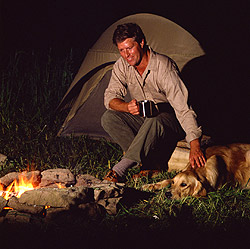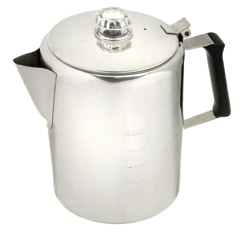
 |
| There are plenty choices for a portable coffee Percolator to ensure you get the best brew in the backwoods. |
Everything tastes better outdoors. This is especially true of a good cup of coffee at camp. One of my favorite morning rituals is to enjoy an early morning cup of joe at the waterside and watch the sunrise. Outdoor and brewed aromas combine as both nature and I wake up to another day. Here are some tips on how to brew a great cup of coffee for connoisseurs who know that instant isn't an option.
Outdoor Coffee Equipment
You don't need to sacrifice a lot of the modern comforts when it comes to coffee in the outdoors if you're willing to haul a little extra gear. Those used to drip-brewed coffee will be pleased with Coleman's Camping Coffeemaker. This steel-based gadget will work over any of Coleman's two or three burner stoves. It'll brew a pot of coffee as good as you'll get at home. The maker uses paper filters so no grounds get in your cup. If you're concerned about keeping things light and your gear to a minimum, the only downside of the maker is its size.
The standard camp percolator is another option to brewing a cup of coffee. Functional with flexible heating options, from campfire to stove, percolators have been providing outdoorsmen with coffee for decades. The trick to percolators is timing the perfect brew. When it comes to time, too little and the coffee won't be strong enough, too long and it will be too strong and too bitter of a brew.
To ensure the proper strength coffee, watch the maker's clear dome and monitoring the darkness of the coffee that's bubbling up the percolator's tube. When using a percolator, it's important to remove the coffee from the heat source and not to boil the coffee, which quickly ruins the taste and aroma.
Two even smaller brewing options exist for backwoods brewing. One is a portable Espresso Maker. The unit's steel base holds both grounds and water. When put over a heat source, it won't take long for the maker's metal tube to drip out thick coffee with a dark foam into your cup. These units are ideal for small, one-burner stoves and ultra-light backpack camping.
The second ultra-light option are one-cup coffee filters and brewers. The most basic option is using a small, one-cup filter. Simply run a metal or plastic rod through the paper filter (or use a wire mesh model) and hold it above the mug. If you're not interested in holding the filter as the coffee brews, you can purchase models that include plastic filter baskets that sit over a mug.
In both cases, brewing a cup is as simple as adding grounds to the filter, slowly pouring hot water into the filters and then waiting for the mug to fill. If just using a filter, it's safer to place the filter in the mug, pour water to fill it, and then raise and lower the filter, letting water drip through the grounds until the cup is brewed to your liking. This way, you won't risk scalding your hands with hot water.
![]() WATCH VIDEO BELOW: where we tested several ways to make coffee while camping. What's your favorite way?
WATCH VIDEO BELOW: where we tested several ways to make coffee while camping. What's your favorite way?
7 Tips for the Best Cup of Coffee
Regardless of what type of gear you own to make a cup of coffee, some basic rules apply to ensure the cup you drink is aromatic, flavorful, and hot.
 |
| The trick to a camp coffee percolator is timing the perfect brew. |
1. First and foremost, always make sure you clean your equipment after each use. Next, use fresh, cold water for brewing. If you're in the backcountry, ensure you use a water filter. This will remove minerals and chemicals to make water taste better, but it will also remove microorganisms that can make you ill.
2. When it comes to beans and grinding them, some coffee connoisseurs take things very seriously. Personally, my palate isn't very refined, but I do notice a difference in a few things when it comes to beans.
First off, you get what you pay for. If you're looking for a good cup of coffee, opt for buying grounds from a coffee shop. To take things a step further, look for shops that roast beans on site or locally. These recently-roasted beans will be more flavorful than those roasted weeks ago and sitting on supermarket shelves. Store beans in an air-tight container and keep them away from sunlight to preserve their freshness. Never store coffee in the freezer or refrigerator. If storing coffee with your food during a camping trip, keep it away from onions, garlic and other potent items as coffee can absorb flavors from foods.
3. Next, delay grinding beans, if you can, until you're ready to brew. Once ground, coffee beans quickly release their aromatic oils into the air. The closer beans are ground to brewing time the more flavorful and aromatic the cup.
4. If electricity is available, small grinders are inexpensive and take up little space. To grind beans when in remote areas without electricity, the options are investing in a battery operated or a manual, mill-style coffee grinder. Whether this is a hassle or not depends on how much effort a great-tasting cup of coffee is worth to you.
5. Once you've got your grounds ready, the standard coffee-making rule is one tablespoon per cup of coffee. When I'm making more than four cups of coffee, I always add an extra tablespoon "for the pot." It results in a slightly stronger brew. Most coffee shops sell measuring spoons that make early morning measurements easy.
6. Once the coffee is ready, serve it immediately for the best taste. Leaving coffee on a heat source for more than 15 minutes will lead to a stale-tasting brew. Also, don't re-heat coffee or re-use grounds. If you need more coffee, start the brewing process over for best results.
7. A thermos is a great way to take coffee with you in the field. If possible, pre-heat the thermos with hot water while your coffee brews. Once the java is ready, pour out the hot water and replace with fresh, hot coffee. Add any milk, cream or sugar and tightly cap the thermos.
These are just a few suggestions on how to get the best tasting cup of coffee when outdoors. Of course, you might not have access to all of the modern appliances and gadgets, but keep in mind that coffee's been made for centuries. If a great cup is critical to your daily routine, there are plenty of portable options to ensure you get the best brew. Lastly, don't be ashamed of your desire for great tasting coffee. Sure, you might take a bit of friendly ribbing from your pals, but ultimately they'll be thankful to have a backwoods barista in their company serving them flavorful java. After all, life's too short to drink bad coffee.
- 10802 views

